The macroeconomic outlook presents both challenges and opportunities for businesses. Sustainability, especially closed-loop systems, and cost considerations are crucial in long-term supply planning. CO2 data in supply chains is gathering importance, and while sustainability is improving, significant hurdles remain, such as an increase in ocean freight costs. Cultural shifts towards sustainability are creating new opportunities
In a nutshell…
- Raise questions and accountability. Don’t be afraid to adopt new processes.
- Build and execute plans. Take the leap and act now.
- Push suppliers for data and change. Continuous pressure on suppliers can drive improvements.
- Set small targets. Small steps are better than inaction.
- Share best practices. Collaboration among retailers can enhance sustainability efforts.
- Communicate with suppliers. Clear communication on sustainability intentions is key.
A closer look…
Sustainability in action
Retailers recognise that while cost is critical, sustainability can’t be overlooked. For instance, packaging sourced from China may have economic benefits, but this is often unsustainable and ethically questionable. The journey towards sustainability must consider the entire life cycle of materials, starting with the end in mind.
When it comes to waste, a common misconception that plastic cannot be consistently recycled. In reality, closed-loop systems, such as the one used by Ocado for delivery bags, demonstrate that consistent recycling is possible. Countries like Germany are leading the way, with consumers bringing their own containers to supermarkets—an education piece that could be adopted in other countries.


Practical alternatives to plastic packaging are emerging, though not all are commercially viable yet. Innovations like plastics soluble in salt water offer promising solutions.
Retailers face challenges in addressing the end-of-life for plastics, often relying on long-term agreements (LTAs) without considering the full life cycle. There’s a real need for a broader shift in how sustainability is approached within the industry. Uniform standards for plastic degradation are essential to create a sustainable supply chain. Some retailers have made the decision to entirely eliminate plastics, despite financial losses and well ahead of legislative drivers.
Irrespective of these challenges, there is a greater demand than supply for recyclable materials, driven by incentives like the 30% tax benefit. This presents a significant opportunity for businesses, although the costs are high. The transition to a more sustainable economy is closely linked to the broader shift from oil-based to electric energy sources, which will drive faster and more impactful changes in the use of plastics.
Still to do…
One of the biggest barriers to sustainability is a lack of recycling infrastructure. Although international recycling hubs exist, often shippers are unwilling to transport recyclable materials due to restrictive HS codes, which means recyclable materials can often end up in landfills. Despite many retailers and associations taking the initiative, there’s a need for government intervention to enforce sustainable practices. Legislation might be necessary to drive meaningful change in light of the costs.
Another concern for Retail Hive members is ocean freight costs, exacerbated by the current economic climate. Businesses need to explore alternative logistics strategies and consider onshoring where feasible to mitigate this issue. Sustainability improvements in general, while accelerating, still face hurdles. Collaboration between retailers, manufacturers, and suppliers is crucial to overcoming these challenges, with a particular focus on end-of-life solutions for materials and consistent recycling policies.
Cultural shifts towards sustainability are gaining momentum, driven by consumer demand and regulatory pressures. Businesses must adapt to these changes, prioritising sustainability in their operations. This involves rethinking packaging, investing in sustainable materials, and educating consumers about sustainable practices.



